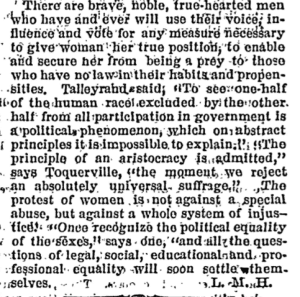 Susan M. Chambers
Susan M. Chambers
Katy, Texas
Volume XIII, Number 3, Spring 1987
He has on a United States Navy uniform, and she has on a ocher suit with a brown bow at the neck and a brown hat. Her bouquet is of yellow roses and white carnations. They are both rosy-cheeked and bright-eyed. You can’t be sure of those colors though—it’s one of those tinted pictures of the 1940s. They look pure, clean and most of all, young.
It’s April 19, 1945. The wedding was at the Naval Air Station in Alameda, California, in the Protestant chapel. She had come from Texas on the train to marry him. He was from Pennsylvania, an air machinist mate in the U. S. Navy and very charming. When you look at their picture, you can see so much. You see fun, caring, and naivete.
If they knew what was to come, would they have smiled or hoped or cared or even married? She was leaving a life of shelter and maternal domination to live thirty-seven years with a man whom she hardly knew. He was an orphan—by way of murder and suicide—who had been reared in an orphanage and who had no concept of what home and family meant. They had nothing except each other and their energies.
They rented a room in Alameda. When he wasn’t on duty at the Naval Air Station, they roamed San Francisco together. She learned of a world that she never knew existed—a world of freedom, of different people, of joy and of him. In another photograph of them, they are standing beside a lake with a sailboat in it. Their faces show happiness and eagerness but not so much naivete.
Out of the next thirty-seven years, the first and the last twelve or so were serene and marvelous. In between, they had two daughters who disappointed them in one way or another. They were poor; they were more than comfortable. They both used some of that 1945 energy and got educations—he in industrial engineering and she in nursing. They presented a united front, and they fought privately. He made money, and she spent it. He yelled and fussed, and she went to her room and took pills. He ranted and raved, and she soothed and patted.
Sometimes, they both gave much more than they got. He stood strong beside her when she wanted to leave life in attempted suicide, and she stood strong when it came time to give him back to God. But, through it all, they loved each other and stood together firm. When talk of parting came, it was not real. They were a pair.
One day, that handsome young sailor’s face became gray, drawn, and very thin. The dark hair with it’s cowlick was gone because of radiation and chemotherapy, that sailor’s physique (a word he liked) became wasted with only skin stretched over bones. She lost that look of expectation as she watched him suffer and slowly die. Sometimes she wanted to go with him. She rarely left his bedside. They prayed together, and they read books on death and dying. They planned his funeral and the will. He was never temperish in his suffering but stoical and dignified. She sat with him, prayed for and with him, fed him, and washed his body. She doctored the bedsores what were eating on him and fretted when she forgot to brush his teeth. He died quietly, demanding nothing. She closed his eyes.
When he died, she didn’t cry much. She loved him. She knew that he was peaceful and free of pain. She cared enough to let him go. In his casket, there was still the face of that young sailor, with wrinkles of time and knowledge, wrinkles of joy and laughing, but with the creases of pain and care gone. He was just as handsome in his coffin as he had been in San Francisco in 1945.
The love that shined from their eyes in 1945 lasted until 1982. She still carries it and, in her way, grieves every day for that young man who lured her to California with grand promises. They gave to each other in way and for times unknown to them in that photograph taken in 1945.
Was parting that way—with such pain to them both—worth joining together to begin with? They thought so.





